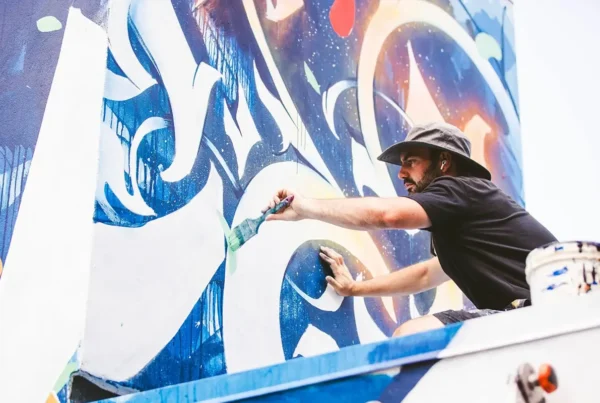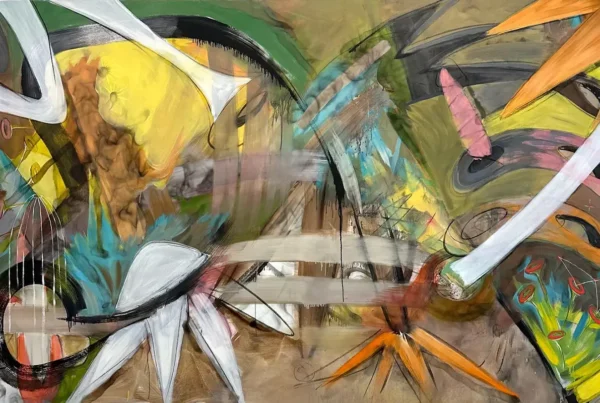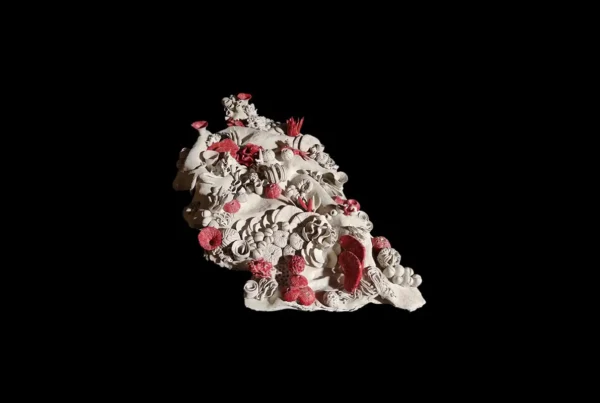“Painting offers something that film cannot: stillness. It resists the momentum of the narrative and compels the viewer to linger.”
Echoes of Origin: Tracing the Artistic Seed
The story of Anugrah Mishra begins in India, where a young boy once sketched a grand portrait of Lord Hanuman at the age of eight—a moment that marked the genesis of an artistic voice now resonating far beyond borders. Today, Mishra is a contemporary artist based in London, whose work transcends mere aesthetics to explore the undercurrents of social, political, and psychological upheaval. Born into a middle-class Indian family, he grew up immersed in the complex interactions between community, culture, and power—an environment that would later feed the thematic force of his art. These early experiences not only offered a lens into the lives of ordinary people but also sparked a deep conviction that painting could serve as a tool for reflection and, perhaps, transformation.
Mishra’s art does not seek to embellish reality but to expose its fragility and rawness. Over time, his sensitivity to human suffering and structural injustice evolved into a deeper inquiry into how the psyche endures crises. He became increasingly drawn to how trauma lingers—not just on the body or in the streets, but within the architecture of memory itself. As he matured as an artist, he found that his purpose was not simply to paint stories, but to make visible the silent emotional undercurrents that shape those stories. His studio became a space of inquiry where color, form, and absence interrogated grief, exile, and resilience.
Rather than adopt a detached or observational stance, Mishra chose to immerse himself in the emotional atmosphere of his subjects. This approach led him to explore the psychoanalytical layers of displacement and identity, guiding both his themes and techniques. The socio-political influences of his youth, combined with a growing awareness of psychological trauma, inform every aspect of his process—from his choice of palette to the spatial design within his compositions. His work is a meditation not on spectacle, but on the quieter, interior aspects of crisis—those unseen mental geographies people inhabit when forced from their homes, identities, and histories.

Anugrah Mishra: The Uncharted Path of Becoming
For Mishra, becoming an artist was less a calculated decision and more an existential leap. He describes his entry into the art world not as a product of external motivation but as an instinctive response to an internal calling. At sixteen, just out of high school, he felt compelled to follow a path he could neither fully explain nor ignore. The uncertainties of an artistic life didn’t dissuade him; instead, they confirmed the spiritual gravity of his choice. It was the beginning of a life marked not by certainty but by exploration—of technique, of self, and of the stories others carried within them.
In his early years, Mishra immersed himself in the works of the old masters—Raja Ravi Varma, Leonardo da Vinci, Michelangelo, Rembrandt, and Titian. He studied their compositions and techniques, dissecting them stroke by stroke. Alongside these classical influences, he also gravitated towards impressionists and modern painters like Van Gogh, Matisse, and Picasso, drawing lessons from their emotional intensity and compositional daring. This dual lineage—rooted both in traditional Indian art and Western classical and modern styles—provided a layered foundation that allowed him to develop a language both familiar and distinctly personal. Art history became his second education, one he pursued with curiosity and independence long before formal training.
Eventually, Mishra sought academic grounding, enrolling in a foundational fine art course in Mumbai. When the pandemic reshaped the world, it also redefined his journey. Using that moment of global stillness as an opportunity, he continued his studies in the United Kingdom, enrolling in the Cambridge School of Art at Anglia Ruskin University. His time in the UK has been marked by critical growth and artistic recognition, including exhibitions across London and Cambridge, and winning the prestigious 2024 Freelands Painting Prize. Each stage of his career has expanded his approach, allowing him to move from technical mastery to conceptual depth, and from replication to innovation.
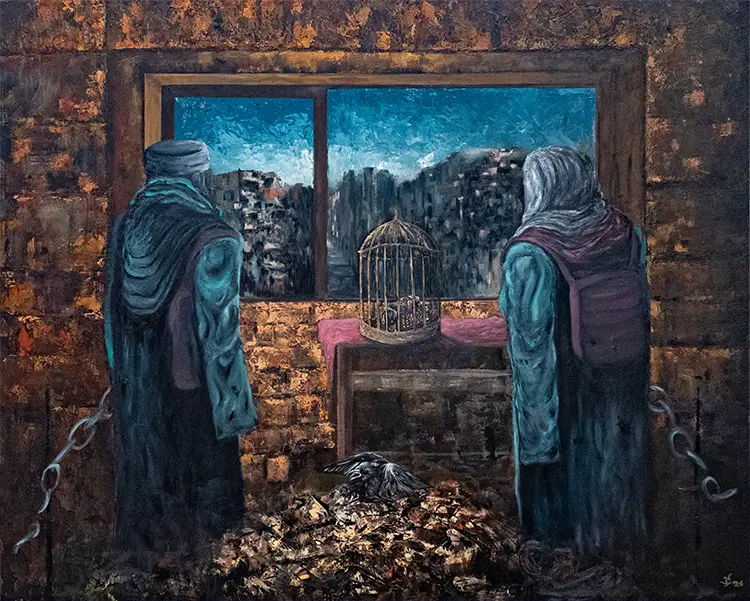
Mapping the Interior: Themes of Displacement and Memory
Mishra’s current body of work explores the emotional terrain of the refugee crisis through a psychological lens. His paintings are not literal representations of conflict or exodus; they are immersive explorations of the unseen wounds left by dislocation. Working primarily in oil and mixed media, he constructs atmospheric compositions that shift between symbolic realism and expressive abstraction. His technique mirrors the instability of his subjects: brushstrokes fluctuate between precision and disorder, between clarity and erasure. Each piece functions as an emotional landscape, a suspended moment where memory, grief, and survival coexist in uneasy silence.
His thematic focus on forced migration, loss, and resilience finds expression in evocative spatial imagery. Interiors are recurring motifs—rooms that speak of abandonment, markets shadowed by disorientation, and birds caught between the ruin of yesterday and the possibility of tomorrow. These elements are not decorative; they are psychological constructs, extensions of the human mind struggling to make sense of a fractured existence. The architecture of space becomes a metaphor for the architecture of memory. By situating his figures in liminal, unstable environments, Mishra captures the emotional residue that often goes undocumented—the aftermath of trauma, the loneliness of exile, and the quiet dignity of endurance.
Rather than portray refugees as passive subjects or reduce their experience to narrative tropes, Mishra invites the viewer to engage with emotional complexity. He uses stillness as a device of resistance—against oversimplification, against voyeurism, against the relentless demand for resolution. In his own words, painting offers something film cannot: a suspension of time that insists on contemplation. His work refuses closure. It prefers ambiguity, distortion, and layered meaning, allowing each viewer to confront their own interpretations. In this way, his paintings become collaborative acts of witnessing, shaped as much by the viewer’s projections as by the artist’s intent.
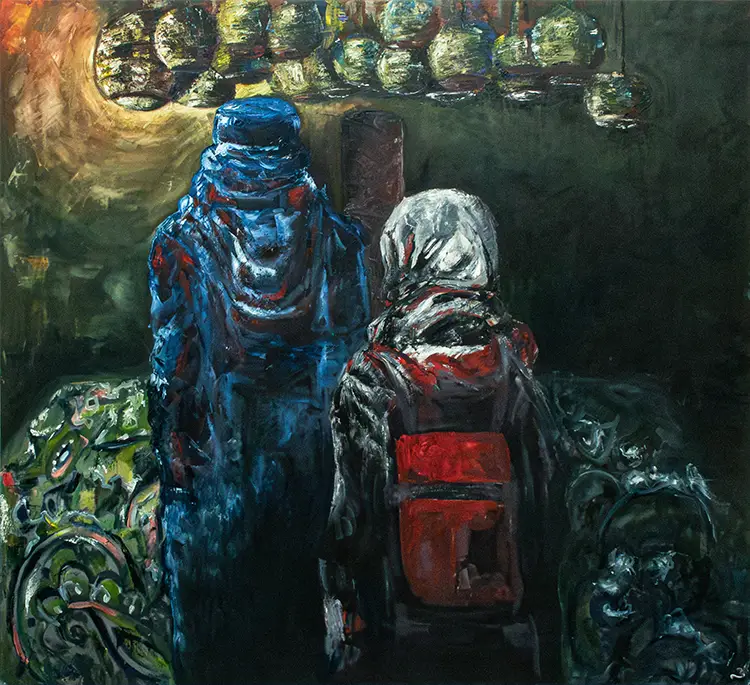
Anugrah Mishra: Material, Method, and Meditative Process
In Mishra’s practice, the material is never an afterthought—it is a central dialogue partner in the process of meaning-making. He primarily works with oil and acrylic, often layering them to achieve both immediacy and subtlety. Acrylic enables him to act quickly, to channel urgent gestures, while oil allows for introspection and emotional depth. The push and pull between the two mirrors the thematic dualities he explores: crisis and endurance, fragmentation and continuity, absence and presence. His choice of medium is always responsive to the emotional demand of the subject, resulting in work that is as technically rich as it is emotionally resonant.
While painting remains his most intuitive form of expression, Mishra has explored other materials—charcoal, ink, digital tools—but none have matched the tactile intimacy painting offers. For him, the act of applying paint is not merely technical; it is a somatic engagement, a bodily form of knowing. The slowness of painting allows for thought, distortion, and reflection—qualities essential when dealing with subjects as layered as grief and migration. In a world that often demands speed and spectacle, Mishra’s process is a quiet resistance. It is about sitting with silence, embracing the unresolved, and honoring those liminal psychological states that do not yield easily to narrative.
His studio is an extension of this meditative process. A cup of coffee, classical Indian music, and a silent phone help him enter a space of focus and introspection. He keeps his tools organized, knowing that clarity in his environment facilitates clarity in execution. This disciplined approach allows him to manage distractions and maintain emotional connection with his work. Influences from Da Vinci, Ai Weiwei, Peter Doig, and others continue to echo through his process—not just in style, but in their commitment to pushing artistic boundaries. Mishra’s own journey is marked by this same impulse: to explore without constraint, to document without exploiting, and to create without compromise.
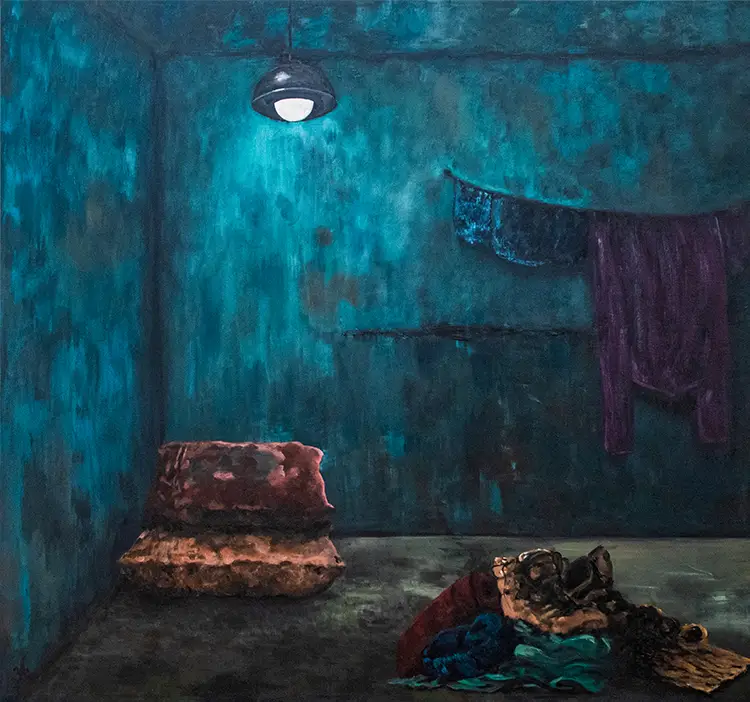
Acknowledgments: Honoring Those Who Made the Journey Possible
Mishra’s artistic journey, though deeply personal, has never been solitary. Along the way, he has been supported, guided, and encouraged by individuals and institutions whose contributions have shaped both his practice and his path.
He extends heartfelt gratitude to his mentor, Probir Ghosh, whose guidance in India helped lay the foundation for his creative development. He also acknowledges Benet Spencer, his fine art tutor, whose insights and mentorship during his time at the Cambridge School of Art (Anglia Ruskin University) have been pivotal to his growth as an artist.
Mishra further expresses his appreciation to the Freelands Foundation, whose recognition through the 2024 Freelands Painting Prize has been an important milestone in his career. Special thanks also go to photographer Hydar Dewachi (@hydardewachi) for the still images that accompany this work, capturing the essence of his artistic vision with care and precision.
For Mishra, these relationships are not just professional connections—they are part of the larger constellation of support that continues to sustain his journey between stillness and survival.



